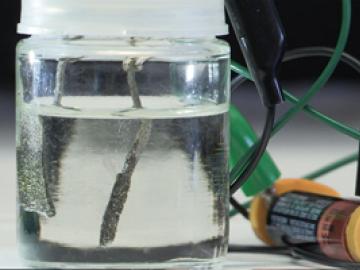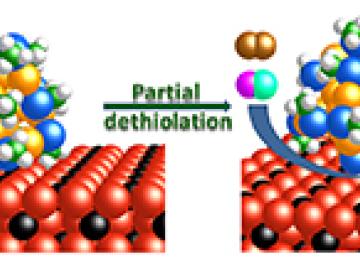Filter News
Area of Research
- (-) Materials Synthesis from Atoms to Systems (8)
- (-) National Security (2)
- Advanced Manufacturing (4)
- Biological Systems (3)
- Biology and Soft Matter (3)
- Building Technologies (3)
- Chemical and Engineering Materials (2)
- Chemistry and Physics at Interfaces (5)
- Clean Energy (20)
- Climate and Environmental Systems (4)
- Computational Biology (1)
- Computational Chemistry (4)
- Computational Engineering (1)
- Computer Science (1)
- Earth Sciences (1)
- Energy Frontier Research Centers (6)
- Fuel Cycle Science and Technology (1)
- Functional Materials for Energy (8)
- Fusion and Fission (1)
- Geographic Information Science and Technology (1)
- Isotopes (1)
- Materials (32)
- Materials for Computing (7)
- Materials Under Extremes (5)
- Neutron Data Analysis and Visualization (2)
- Neutron Science (7)
- Nuclear Science and Technology (5)
- Nuclear Systems Technology (1)
- Quantum Condensed Matter (2)
- Renewable Energy (1)
- Sensors and Controls (1)
- Supercomputing (15)
- Transportation Systems (3)
News Type
News Topics
Media Contacts
ORNL drone and geospatial team becomes first to map the Coca River in the Amazon basin as erosion and sediment threaten Ecuador’s lands.

Jack Orebaugh, a forensic anthropology major at the University of Tennessee, Knoxville, has a big heart for families with missing loved ones. When someone disappears in an area of dense vegetation, search and recovery efforts can be difficult, especially when a missing person’s last location is unknown. Recognizing the agony of not knowing what happened to a family or friend, Orebaugh decided to use his internship at the Department of Energy’s Oak Ridge National Laboratory to find better ways to search for lost and deceased people using cameras and drones.





A simple new technique to form interlocking beads of water in ambient conditions could prove valuable for applications in biological sensing, membrane research and harvesting water from fog.

Researchers at the Department of Energy’s Oak Ridge National Laboratory have developed a new and unconventional battery chemistry aimed at producing batteries that last longer than previously thought possible.

Treating cadmium-telluride (CdTe) solar cell materials with cadmium-chloride improves their efficiency, but researchers have not fully understood why.

Photovoltaic spray paint could coat the windows and walls of the future if scientists are successful in developing low-cost, flexible solar cells based on organic polymers. Scientists at the Department of Energy’s Oak Ridge National Laboratory recently discovered an unanticipated factor in the performance of polymer-based solar devices that gives new insight on how these materials form and function.




